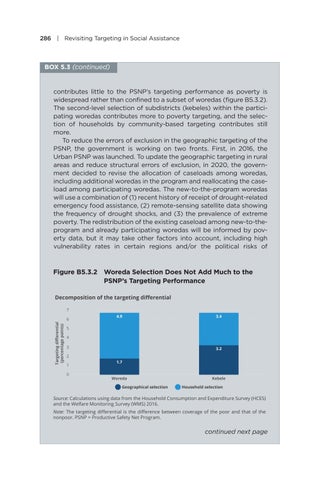286 | Revisiting Targeting in Social Assistance
BOX 5.3 (continued)
contributes little to the PSNP’s targeting performance as poverty is widespread rather than confined to a subset of woredas (figure B5.3.2). The second-level selection of subdistricts (kebeles) within the participating woredas contributes more to poverty targeting, and the selection of households by community-based targeting contributes still more. To reduce the errors of exclusion in the geographic targeting of the PSNP, the government is working on two fronts. First, in 2016, the Urban PSNP was launched. To update the geographic targeting in rural areas and reduce structural errors of exclusion, in 2020, the government decided to revise the allocation of caseloads among woredas, including additional woredas in the program and reallocating the caseload among participating woredas. The new-to-the-program woredas will use a combination of (1) recent history of receipt of drought-related emergency food assistance, (2) remote-sensing satellite data showing the frequency of drought shocks, and (3) the prevalence of extreme poverty. The redistribution of the existing caseload among new-to-theprogram and already participating woredas will be informed by poverty data, but it may take other factors into account, including high vulnerability rates in certain regions and/or the political risks of
Figure B5.3.2 Woreda Selection Does Not Add Much to the PSNP’s Targeting Performance Decomposition of the targeting differential 7 Targeting differential (percentage points)
6
4.9
3.4
5 4 3
3.2
2 1 0
1.7
Woreda
Geographical selection
Kebele
Household selection
Source: Calculations using data from the Household Consumption and Expenditure Survey (HCES) and the Welfare Monitoring Survey (WMS) 2016. Note: The targeting differential is the difference between coverage of the poor and that of the nonpoor. PSNP = Productive Safety Net Program.
continued next page


